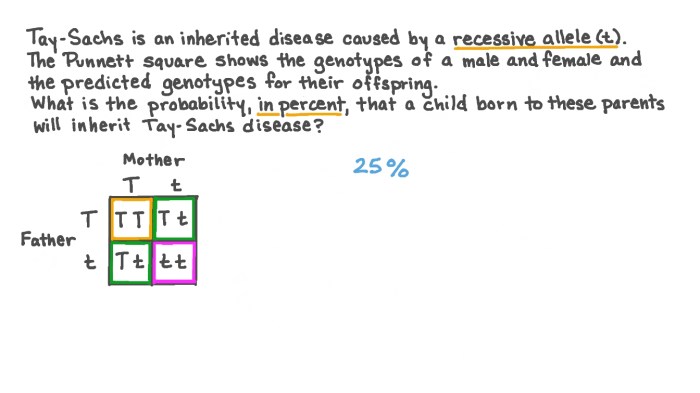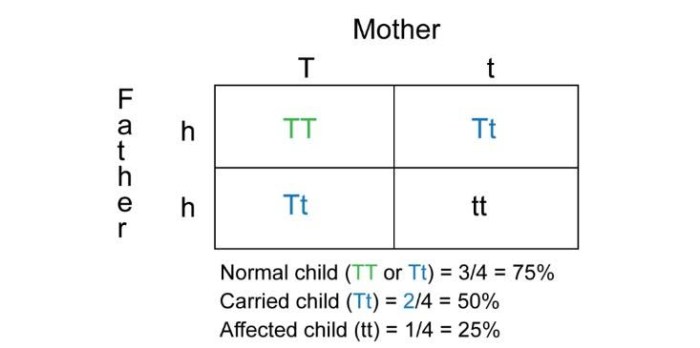Punnett square tay sachs disease – Punnett squares provide a valuable tool for understanding the inheritance patterns of genetic diseases like Tay-Sachs disease. This article explores the concept of Punnett squares and their application in Tay-Sachs disease, providing insights into genotype-phenotype correlations, carrier status, genetic counseling, and screening methods.
Tay-Sachs disease is a rare but devastating genetic disorder that affects the nervous system. It is caused by mutations in the HEXA gene, which leads to a deficiency of the enzyme hexosaminidase A. This enzyme is essential for breaking down a fatty substance called GM2 ganglioside, which accumulates in the brain and other organs, causing progressive neurological damage.
Tay-Sachs Disease Overview

Tay-Sachs disease is a fatal genetic disorder caused by a mutation in the HEXA gene, which encodes an enzyme called hexosaminidase A. This enzyme is responsible for breaking down a fatty substance called GM2 ganglioside, which accumulates in the brain and other organs in individuals with Tay-Sachs disease.
The accumulation of GM2 ganglioside leads to progressive neurological damage, resulting in a range of symptoms and ultimately death.
The symptoms of Tay-Sachs disease typically appear in infancy and progress rapidly. They include:
- Loss of motor skills
- Muscle weakness
- Seizures
- Blindness
- Hearing loss
- Intellectual disability
There is currently no cure for Tay-Sachs disease, and treatment is focused on managing the symptoms and providing supportive care.
Punnett Squares for Tay-Sachs Disease

Punnett squares are a tool used in genetics to predict the possible genotypes and phenotypes of offspring. In the case of Tay-Sachs disease, a Punnett square can be used to illustrate the inheritance pattern of the disease.
Tay-Sachs disease is an autosomal recessive disorder, which means that both copies of the HEXA gene must be mutated in order for an individual to develop the disease. Carriers of Tay-Sachs disease have one mutated copy of the HEXA gene and one normal copy.
They do not develop the disease themselves, but they can pass the mutated gene on to their children.
The following Punnett square shows the possible genotypes and phenotypes of offspring when both parents are carriers of Tay-Sachs disease:
“`| | H | h ||—|—|—|| H | HH | Hh || h | Hh | hh |“`
As shown in the Punnett square, there is a 25% chance that a child of two carrier parents will inherit two mutated copies of the HEXA gene and develop Tay-Sachs disease. There is a 50% chance that a child will inherit one mutated copy of the HEXA gene and be a carrier, and a 25% chance that a child will inherit two normal copies of the HEXA gene and not be a carrier.
Genotype and Phenotype in Tay-Sachs Disease

The genotype of an individual refers to the combination of alleles that they inherit for a particular gene. The phenotype of an individual refers to their observable characteristics, such as their physical appearance and behavior.
In the case of Tay-Sachs disease, there are three possible genotypes:
- HH: Homozygous dominant (two normal copies of the HEXA gene)
- Hh: Heterozygous (one normal copy and one mutated copy of the HEXA gene)
- hh: Homozygous recessive (two mutated copies of the HEXA gene)
The following table summarizes the genotype-phenotype correlations in Tay-Sachs disease:
| Genotype | Phenotype ||—|—|| HH | Normal || Hh | Carrier || hh | Tay-Sachs disease |
Carrier Status and Genetic Counseling
Carrier status refers to the condition of carrying one mutated copy of a gene for a recessive disorder, such as Tay-Sachs disease. Carriers do not develop the disease themselves, but they can pass the mutated gene on to their children.
Genetic counseling is a process that helps individuals understand their risk of having a child with a genetic disorder, such as Tay-Sachs disease. Genetic counselors can provide information about the inheritance pattern of the disorder, the risks of having an affected child, and the options available for screening and prevention.
Genetic counseling is recommended for individuals who have a family history of Tay-Sachs disease or who are of Ashkenazi Jewish descent, as this population has a higher risk of carrying the Tay-Sachs disease mutation.
Screening and Prevention of Tay-Sachs Disease
Screening for Tay-Sachs disease is available to identify carriers and individuals who are at risk of having an affected child. Screening can be done through a blood test or a DNA test.
Prevention of Tay-Sachs disease is possible through carrier screening and prenatal diagnosis. Individuals who are identified as carriers can make informed decisions about having children and can choose to use preimplantation genetic diagnosis (PGD) to prevent the transmission of the Tay-Sachs disease mutation to their children.
Prenatal diagnosis can be used to determine if a fetus has Tay-Sachs disease. This can be done through chorionic villus sampling (CVS) or amniocentesis.
FAQ Overview: Punnett Square Tay Sachs Disease
What is the most common type of Tay-Sachs disease?
The most common type of Tay-Sachs disease is infantile Tay-Sachs disease, which typically manifests in infants between 3 and 6 months of age.
Is Tay-Sachs disease curable?
Currently, there is no cure for Tay-Sachs disease. Treatment focuses on supportive care to manage symptoms and improve quality of life.
What is the role of genetic counseling in Tay-Sachs disease?
Genetic counseling plays a crucial role in Tay-Sachs disease management. It provides information about the inheritance pattern, risk assessment, and reproductive options to help families make informed decisions.